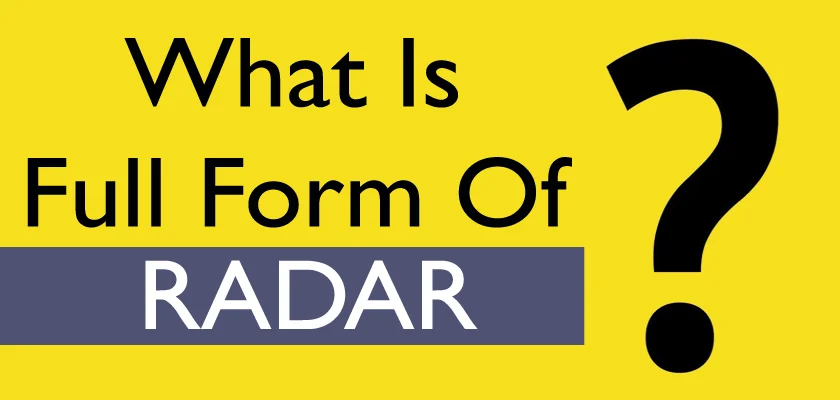Do you know what is the RADAR Full Form? The full form of RADAR stands for Radio Detection and Ranging. It is a security-based technology that produces radio waves to detect the distance, direction, speed, and other properties of the object. Along with this, it is a surveillance technique that monitors ships, planes, weapon systems, satellites, weather patterns, automobiles, and topography.
Table of Contents
What is the RADAR Full Form?
RADAR Full Form: Radio Detection and Ranging
There are many uses for RADAR technology, including navigation and military surveillance in addition to air traffic control and weather forecasting. Numerous other civilian uses for it include marine navigation, automotive safety systems, and even some sports equipment.
RADAR systems come in a variety of varieties, each created for a particular use. For instance, while ground-based RADAR can be used for air traffic control, weather forecasting, and maritime navigation, airborne RADAR is used to find and track aircraft. As a result of the revolutionary changes brought about by RADAR technology, it is now a crucial tool for a wide range of industries and applications.
History of RADAR
Several countries, including the United States, Britain, Germany, and Japan, had secretly developed and deployed RADAR systems for military purposes.
The United States Navy introduced the term “RADAR” in 1940. Today, the general public is familiar with radar as it is commonly used by law enforcement to measure the speed of vehicles. This type of radar utilizes the Doppler effect to calculate an object’s radial speed vector but does not display its precise position.
RADAR System Components/ Working Principle of RADAR
The following is the working principle or components of RADAR:
Transmitter
- The transmitter is a crucial interface that connects the system to the outside world.
- It generates a signal using a waveform generator.
- The signal is amplified using a power converter.
- Common power supplies include Klystron, Traveling Wave Tubes, and Magnetron.
Waveguides
- RADAR radiation is sent through transmission cables called waveguides.
Antennas
- The antenna is responsible for transmitting the signal into the surrounding space and receiving the reflected signals.
- The type of antenna used can vary depending on the specific application and requirements.
- Common types of antennas include parabolic mirrors, rectangular arrays, and electrically steered phased arrays.
Duplexer
- The duplexer allows the antenna to switch between transmitting and receiving modes.
- It ensures efficient use of the RADAR system.
- It may use a chemical device that creates a circuit at the receiver’s input when the broadcaster is turned on.
Different types of RADAR
The following are the types of RADAR:
- Bistatic Radar: Tx and Rx are separated by distance for long-range military use.
- Monopulse Radar: Compares signals received from different orientations and polarization.
- Doppler Radar: Uses Doppler Effect to calculate velocity by analyzing signal frequency.
- Pulsed RADAR: Fires high-intensity pulses and waits for the object’s echo signal to determine range and resolution.
- Instrumentation Radar: Used to test aeroplanes, missiles, and rockets.
- Weather Radars: Estimate wind speed and detect rainfall using Doppler shifts.
- Passive Radar: Detects objects using external sources such as advertisements.
RADAR Technology Uses Area
Radar has a wide range of applications in a variety of fields, including:
- Aviation: Radar is used in aviation to locate and track aircraft, provide accurate weather information, and support air traffic control.
- Military and Defense: Radars are widely used in military and defence applications, including early warning systems, ground surveillance, navigation, target tracking, and missile guidance.
- Marine Navigation: Radar is used in marine navigation to locate other ships, track weather patterns, and aid in search and rescue operations.
- Weather forecasting: Radar is used in weather forecasting to track storms and provide detailed information about precipitation and wind patterns.
- Industrial: Radars are used in industrial applications such as level detection and tank gauging.
- Automotive industry: RADAR is used to provide driver assistance in automotive applications, such as collision avoidance and blind spot detection.

List of Other RADAR Full Forms
| Term | Full Form | Category |
| RADAR | Radio Detection And Ranging | Wireless Technology |
| RADAR | Resource Access Discovery and Retrieval | Networking |
| RADAR | Rochester Area Disabled Athletics and Recreation | Sports |
| RADAR | Radio Detecting and Ranging | Space Science |
FAQs- What is the RADAR Full Form?
Q.1. What is the full form of RADAR?
Ans. The RADAR full form is Radio Detection And Ranging.
Q.2. What is the Radar Full Form in Technology?
Ans. In Technology, the full form of Radar is Radio Detection And Ranging.
Q.3. How many types of RADAR?
Ans. The Radar system has six type. The following is mention below:
- Bistatic Radar
- Monopulse Radar
- Doppler Radar
- Pulsed RADAR
- Instrumentation Radar
- Weather Radars
- Passive Radar
Thanks for reading What is the RADAR Full Form? Bookmark our website Whatisfullform.com to know or read our collection of full forms.


